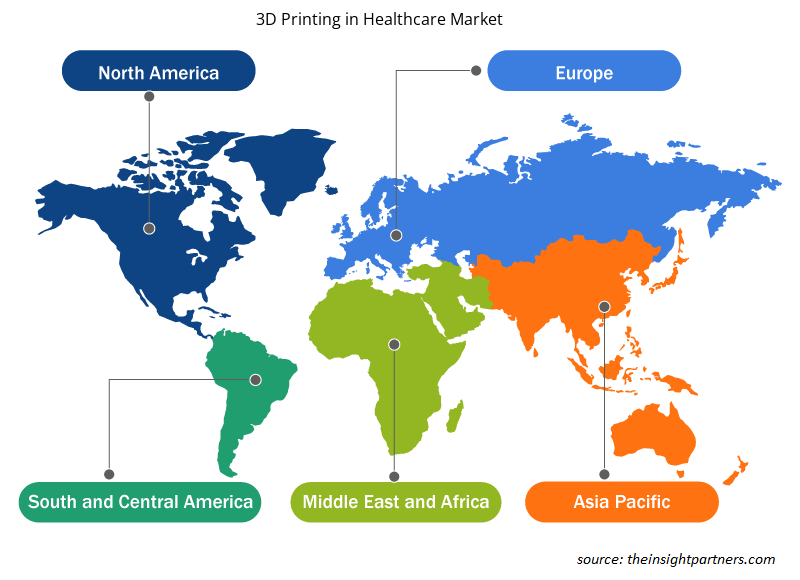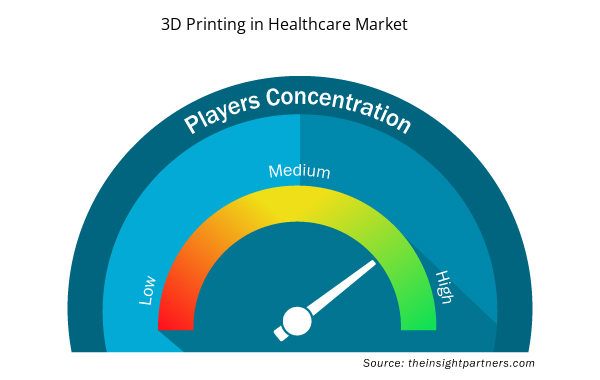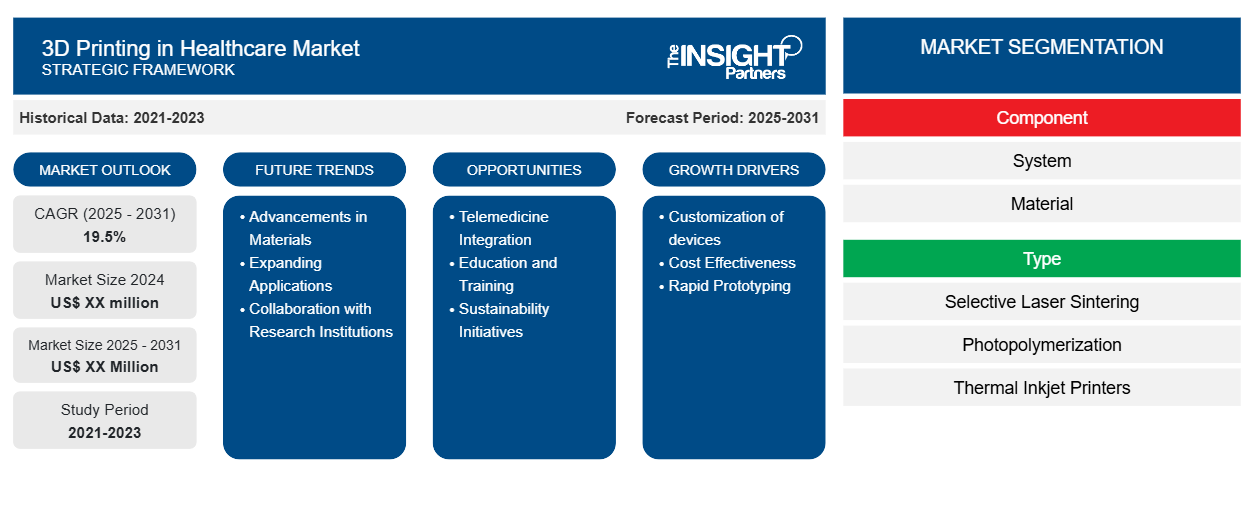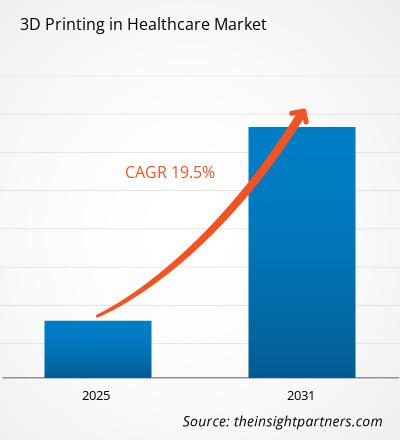ヘルスケア市場における 3D プリンティングは、2023 年から 2031 年にかけて 19.5% の CAGR を記録し、市場規模は 2023 年の XX 百万米ドルから 2031 年には XX 百万米ドルに拡大すると予想されています。
レポートは、コンポーネント(システムおよび材料)別にセグメント化されています。レポートではさらに、血管移植片のタイプ(選択的レーザー焼結、光重合、熱インクジェットプリンター、熱溶解積層法、ステレオリソグラフィー、電子ビーム溶融、およびその他)に基づいて分析を提示します。さらに、市場はアプリケーション(組織と臓器、インプラントとプロテーゼ、整形外科、補聴器、薬物送達デバイス、およびその他)に基づいてセグメント化されています。グローバル分析は、地域レベルと主要国でさらに細分化されています。レポートでは、上記の分析とセグメントの値をUSDで提供しています。
報告書の目的
The Insight Partners によるレポート「ヘルスケア市場における 3D プリンティング」は、現在の状況と将来の成長、主な推進要因、課題、機会を説明することを目的としています。これにより、次のようなさまざまなビジネス関係者に洞察が提供されます。
- テクノロジープロバイダー/メーカー: 進化する市場の動向を理解し、潜在的な成長機会を把握することで、情報に基づいた戦略的意思決定が可能になります。
- 投資家: 市場の成長率、市場の財務予測、バリュー チェーン全体に存在する機会に関する包括的な傾向分析を実施します。
- 規制機関: 市場の濫用を最小限に抑え、投資家の信用と信頼を維持し、市場の完全性と安定性を維持することを目的として、市場における政策と警察活動を規制します。
ヘルスケア市場における3Dプリンティングのセグメンテーション
成分
- システム
- 材料
タイプ
- 選択的レーザー焼結
- 光重合
- サーマルインクジェットプリンター
- 熱溶解積層法
- ステレオリソグラフィー
- 電子ビーム溶解
- その他
応用
- 組織と臓器
- インプラントと補綴物
- 整形外科
- 補聴器
- 薬物送達デバイス
- その他
地理
- 北米
- ヨーロッパ
- アジア太平洋
- 南米と中央アメリカ
- 中東およびアフリカ
地理
- 北米
- ヨーロッパ
- アジア太平洋
- 南米と中央アメリカ
- 中東およびアフリカ
要件に合わせてレポートをカスタマイズする
このレポートの一部、国レベルの分析、Excelデータパックなど、あらゆるレポートを無料でカスタマイズできます。また、スタートアップや大学向けのお得なオファーや割引もご利用いただけます。
- このレポートの主要な市場動向を入手してください。この無料サンプルには、市場動向から見積もりや予測に至るまでのデータ分析が含まれます。
ヘルスケア市場における3Dプリンティングの成長要因
- デバイスのカスタマイズ: 3D プリントにより、個々の患者の解剖学的構造に合わせたカスタム義肢やインプラントなどのパーソナライズされた医療ソリューションの開発が可能になります。3D プリントに関する認識の高まりにより、患者によるカスタマイズされた医療ソリューションの需要が高まり、ヘルスケア市場における 3D プリントの成長を促進しています。
- コスト効率: 医療機器は患者のニーズに応じて製造されるため、必要なものだけを生産することで製造コストと無駄が削減されます。これは機器を製造するためのコスト効率の高い方法であるため、医療提供者にとって魅力的な選択肢であり、3D プリントの需要が高まっています。
- ラピッド プロトタイピング: 製品が随時開発されることにより、医療機器や手術用ツールの開発が加速され、イノベーションと市場投入までの時間が短縮されます。ラピッド プロトタイピング (RP) テクノロジで構築された医療モデルを使用することは、手術計画とシミュレーションの新しいアプローチとなります。これらの技術により、解剖学的オブジェクトを 3D 物理モデルとして再現できるため、外科医は手術介入前に複雑な構造のリアルな印象を得ることができます。
ヘルスケア市場における3Dプリンティングの将来動向
- 材料の進歩: 3D プリントの材料と技術の継続的な改善により、印刷された製品の品質と安全性が向上します。たとえば、金属 3D プリントは、膝、脊椎、頭蓋骨、股関節用のインプラントを、より優れた性能、より優れた適合性、より長い寿命で製造するための医療機器設計の開発に使用されています。
- 拡大するアプリケーション: 整形外科、歯科、手術計画などのさまざまな分野で 3D プリントの使用が増え、新しい市場トレンドが生まれています。さらに、3D プリントは、MRI スキャンや CT を使用して参照モデルを作成する専門家によって使用され、外科医が手術の準備をより適切に行うのに役立ちます。
- 研究機関とのコラボレーション: 企業と研究機関のコラボレーションにより、3D 印刷技術の革新的な応用と進歩が実現します。企業は特定の研究機関のニーズに合わせてプリンターを開発でき、研究機関はそれぞれの要件に合わせて製品を開発します。
ヘルスケア市場における3Dプリンティングの機会
- 遠隔医療の統合: 遠隔医療サイクルに 3D プリントを組み込むことで、薬剤師は受け取った電子処方箋に基づいてパーソナライズされた医薬品を設計および製造できるようになります。したがって、遠隔医療の台頭により、3D プリントを使用した遠隔患者固有のソリューションの機会が生まれます。
- 教育とトレーニング: 3D プリント ツールを使用するには、医療従事者は必要な医療機器や医薬品の開発について適切なトレーニングを受ける必要があります。医療従事者向けに 3D プリント技術のトレーニング プログラムを開発すると、採用と使用を促進できます。さらに、政府は医療従事者に対する 3D プリント技術のトレーニングに重点を置いています。
- 持続可能性の取り組み: 環境に優しい慣行への注目が高まるにつれ、3D プリントで持続可能な材料とプロセスを開発する機会が生まれます。3D プリントは、エネルギーと材料の無駄を減らし、炭素を大量に排出するサプライ チェーンをなくすなど、いくつかの方法で二酸化炭素排出量を削減します。
ヘルスケア市場における3Dプリンティングの地域別洞察
予測期間を通じてヘルスケア市場における 3D プリンティングに影響を与える地域的な傾向と要因は、Insight Partners のアナリストによって徹底的に説明されています。このセクションでは、北米、ヨーロッパ、アジア太平洋、中東、アフリカ、南米、中米にわたるヘルスケア市場における 3D プリンティングのセグメントと地理についても説明します。

- ヘルスケア市場における3Dプリンティングの地域別データを入手
ヘルスケア市場における3Dプリンティングレポートの範囲
| レポート属性 | 詳細 |
|---|---|
| 2023年の市場規模 | XX百万米ドル |
| 2031年までの市場規模 | XX百万米ドル |
| 世界のCAGR(2023年~2031年) | 19.5% |
| 履歴データ | 2021-2022 |
| 予測期間 | 2024-2031 |
| 対象セグメント | コンポーネント別
|
| 対象地域と国 | 北米
|
| 市場リーダーと主要企業プロフィール |
|
ヘルスケア市場における 3D プリントのプレーヤー密度: ビジネス ダイナミクスへの影響を理解する
ヘルスケア市場における 3D プリンティングは、消費者の嗜好の変化、技術の進歩、製品の利点に対する認識の高まりなどの要因により、エンドユーザーの需要が高まり、急速に成長しています。需要が高まるにつれて、企業は提供を拡大し、消費者のニーズを満たすために革新し、新たなトレンドを活用し、市場の成長をさらに促進しています。
市場プレーヤー密度とは、特定の市場または業界内で活動している企業または会社の分布を指します。これは、特定の市場スペースに、その市場規模または総市場価値に対してどれだけの競合相手 (市場プレーヤー) が存在するかを示します。
ヘルスケア市場における 3D プリンティングで事業を展開している主要企業は次のとおりです。
- 3Dシステムズ株式会社
- アルカムAB
- エンビジョンテック株式会社
- SLMソリューショングループAG
- ストラタシス株式会社
免責事項:上記の企業は、特定の順序でランク付けされていません。

- ヘルスケア市場における3Dプリンティングのトップキープレーヤーの概要を入手
主なセールスポイント
- 包括的なカバレッジ: レポートでは、ヘルスケア市場における 3D プリンティングの製品、サービス、タイプ、エンド ユーザーの分析を包括的にカバーし、全体的な展望を提供します。
- 専門家による分析: レポートは、業界の専門家とアナリストの深い理解に基づいてまとめられています。
- 最新情報: このレポートは、最新の情報とデータの傾向を網羅しているため、ビジネスの関連性を保証します。
- カスタマイズ オプション: このレポートは、特定のクライアント要件に対応し、ビジネス戦略に適切に適合するようにカスタマイズできます。
したがって、ヘルスケア市場における 3D プリンティングに関する調査レポートは、業界のシナリオと成長の見通しを解読して理解する道の先導役となる可能性があります。いくつかの正当な懸念があるかもしれませんが、このレポートの全体的な利点は欠点を上回る傾向があります。
- 過去2年間の分析、基準年、CAGRによる予測(7年間)
- PEST分析とSWOT分析
- 市場規模価値/数量 - 世界、地域、国
- 業界と競争環境
- Excel データセット



Report Coverage
Revenue forecast, Company Analysis, Industry landscape, Growth factors, and Trends

Segment Covered
This text is related
to segments covered.

Regional Scope
North America, Europe, Asia Pacific, Middle East & Africa, South & Central America

Country Scope
This text is related
to country scope.
よくある質問
Players operating in the market are Organovo, FormLabs, 3D Systems Corporation, Biobots, Exone Company, Proto Labs, SLM Solutions Group, and Cyfuse Biomedical.
Material segment, by component, dominated the market in 2023.
The 3D Printing in Healthcare Market is estimated to witness a CAGR of 19.5% from 2023 to 2031
North America region dominated the 3D printing in healthcare market in 2023.
Telemedicine Integration act as a opportunity for growth of the market in forecast period.
The major factors driving the 3D printing in healthcare market are:
1. Customization of devices.
2. Rapid Prototyping
Trends and growth analysis reports related to Life Sciences : READ MORE..
1. 3D Systems, Inc.
2. Arcam AB
3. Envisiontec, Inc.
4. SLM Solutions Group AG
5. Stratasys Ltd.
6. Javelin Technologies Inc.
7. Tissue Regeneration Systems Inc.
8. Materialise NV
9. Organovo Holdings, Inc.
10. Biomedical Modeling Inc.
The Insight Partners performs research in 4 major stages: Data Collection & Secondary Research, Primary Research, Data Analysis and Data Triangulation & Final Review.
- Data Collection and Secondary Research:
As a market research and consulting firm operating from a decade, we have published and advised several client across the globe. First step for any study will start with an assessment of currently available data and insights from existing reports. Further, historical and current market information is collected from Investor Presentations, Annual Reports, SEC Filings, etc., and other information related to company’s performance and market positioning are gathered from Paid Databases (Factiva, Hoovers, and Reuters) and various other publications available in public domain.
Several associations trade associates, technical forums, institutes, societies and organization are accessed to gain technical as well as market related insights through their publications such as research papers, blogs and press releases related to the studies are referred to get cues about the market. Further, white papers, journals, magazines, and other news articles published in last 3 years are scrutinized and analyzed to understand the current market trends.
- Primary Research:
The primarily interview analysis comprise of data obtained from industry participants interview and answers to survey questions gathered by in-house primary team.
For primary research, interviews are conducted with industry experts/CEOs/Marketing Managers/VPs/Subject Matter Experts from both demand and supply side to get a 360-degree view of the market. The primary team conducts several interviews based on the complexity of the markets to understand the various market trends and dynamics which makes research more credible and precise.
A typical research interview fulfils the following functions:
- Provides first-hand information on the market size, market trends, growth trends, competitive landscape, and outlook
- Validates and strengthens in-house secondary research findings
- Develops the analysis team’s expertise and market understanding
Primary research involves email interactions and telephone interviews for each market, category, segment, and sub-segment across geographies. The participants who typically take part in such a process include, but are not limited to:
- Industry participants: VPs, business development managers, market intelligence managers and national sales managers
- Outside experts: Valuation experts, research analysts and key opinion leaders specializing in the electronics and semiconductor industry.
Below is the breakup of our primary respondents by company, designation, and region:

Once we receive the confirmation from primary research sources or primary respondents, we finalize the base year market estimation and forecast the data as per the macroeconomic and microeconomic factors assessed during data collection.
- Data Analysis:
Once data is validated through both secondary as well as primary respondents, we finalize the market estimations by hypothesis formulation and factor analysis at regional and country level.
- Macro-Economic Factor Analysis:
We analyse macroeconomic indicators such the gross domestic product (GDP), increase in the demand for goods and services across industries, technological advancement, regional economic growth, governmental policies, the influence of COVID-19, PEST analysis, and other aspects. This analysis aids in setting benchmarks for various nations/regions and approximating market splits. Additionally, the general trend of the aforementioned components aid in determining the market's development possibilities.
- Country Level Data:
Various factors that are especially aligned to the country are taken into account to determine the market size for a certain area and country, including the presence of vendors, such as headquarters and offices, the country's GDP, demand patterns, and industry growth. To comprehend the market dynamics for the nation, a number of growth variables, inhibitors, application areas, and current market trends are researched. The aforementioned elements aid in determining the country's overall market's growth potential.
- Company Profile:
The “Table of Contents” is formulated by listing and analyzing more than 25 - 30 companies operating in the market ecosystem across geographies. However, we profile only 10 companies as a standard practice in our syndicate reports. These 10 companies comprise leading, emerging, and regional players. Nonetheless, our analysis is not restricted to the 10 listed companies, we also analyze other companies present in the market to develop a holistic view and understand the prevailing trends. The “Company Profiles” section in the report covers key facts, business description, products & services, financial information, SWOT analysis, and key developments. The financial information presented is extracted from the annual reports and official documents of the publicly listed companies. Upon collecting the information for the sections of respective companies, we verify them via various primary sources and then compile the data in respective company profiles. The company level information helps us in deriving the base number as well as in forecasting the market size.
- Developing Base Number:
Aggregation of sales statistics (2020-2022) and macro-economic factor, and other secondary and primary research insights are utilized to arrive at base number and related market shares for 2022. The data gaps are identified in this step and relevant market data is analyzed, collected from paid primary interviews or databases. On finalizing the base year market size, forecasts are developed on the basis of macro-economic, industry and market growth factors and company level analysis.
- Data Triangulation and Final Review:
The market findings and base year market size calculations are validated from supply as well as demand side. Demand side validations are based on macro-economic factor analysis and benchmarks for respective regions and countries. In case of supply side validations, revenues of major companies are estimated (in case not available) based on industry benchmark, approximate number of employees, product portfolio, and primary interviews revenues are gathered. Further revenue from target product/service segment is assessed to avoid overshooting of market statistics. In case of heavy deviations between supply and demand side values, all thes steps are repeated to achieve synchronization.
We follow an iterative model, wherein we share our research findings with Subject Matter Experts (SME’s) and Key Opinion Leaders (KOLs) until consensus view of the market is not formulated – this model negates any drastic deviation in the opinions of experts. Only validated and universally acceptable research findings are quoted in our reports.
We have important check points that we use to validate our research findings – which we call – data triangulation, where we validate the information, we generate from secondary sources with primary interviews and then we re-validate with our internal data bases and Subject matter experts. This comprehensive model enables us to deliver high quality, reliable data in shortest possible time.


 このレポートの無料サンプルを入手する
このレポートの無料サンプルを入手する